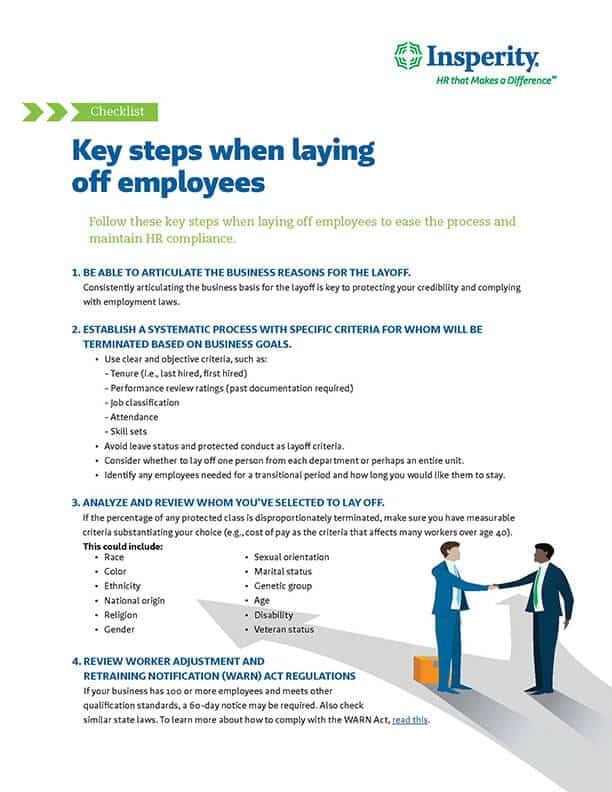Technology advances, economic downturns, business model changes and acquisitions – these are all common challenges that may prompt you to consider laying off employees.
You’ve cinched the purse strings as tight as possible, but layoffs are looming. When it’s time to restructure, cut costs or combine positions, how do you make the tough transition as easy as it can be for you and your employees?
Here are six tips worth pondering.

Checklist: key steps when laying off employees
Layoffs can be some of the most dreaded responsibilities of being an employer. Follow these key steps when laying off employees to ease the process and maintain HR compliance.
1. Establish your game plan
Even after you’ve determined which positions will be eliminated, there are still many other details to iron out. If you want to make the transition as smooth as possible, get a game plan together.
For example, how will you deliver the news? Will any of the employees you’re laying off be needed for a transitional period? Will there be a severance package? If so, will the amount be greater for employees who agree to stay on through a transition?
Also, consider whether you need to give advance notice to employees before the layoff. If your business has 100 or more employees and meets the qualification standards of the Worker Adjustment and Retraining Notification (WARN) Act, a 60-day notice may be required. You should also check the requirements for any similar state law.
Be sure you’ve worked through the details before breaking the bad news.
2. Handle layoff conversations with care
Throughout the life cycle of your employee, mutual respect is your foundation. That respect should have been there through hiring, training, onboarding, coaching and counseling. It shouldn’t be any different when you’re letting an employee go.
It’s always a difficult conversation when you’re giving your employees notice that their jobs are going away. Make sure you express that it’s not the fault of the employee as you share the burdensome news.
For example, you might say, “Due to business reasons – and nothing you’ve done wrong – we’ve had to make some difficult decisions that affect your job. Unfortunately, as a result, [X date] will be your last day of employment with the company.”
When you let the employee know that they aren’t at fault, it will take some of the sting out of the conversation.
3. Identify employees needed for a transitional period
Not every layoff conversation will be the same. There may be some key employees with valuable institutional knowledge who you’d like to stay on for a transitional period.
For instance, say you have five software developers who each work on separate software products. Two of these positions are cut during layoffs, and the three remaining employees now have to step up to take on new and unfamiliar responsibilities.
To ease the transition, you may decide to ask the two software developers cut in the layoff to stay on for a period to help train the three who are staying.
When speaking to these team members, you could say, “We do have some specific needs in the immediate future, and we’d like for you to consider sticking around for a period to help in this process.”
Along with the obvious benefit to your company, this also provides some relief to the departing team members, as it gives them notice before their jobs come to an end.
Through this information-sharing process, you may even discover that some employees – who you intended to lay off – are too valuable to let go. While this may not fit your original game plan, it could save your company from making a costly mistake.
4. Establish incentives for transitional staff
If you’ve asked employees to stay on for a transitional period, help them understand why they’re important to the process.
Consider how you can incentivize employees to stay during this period, too. It’s customary during layoffs to offer perks that encourage staff members to stay on and do a good job.
For example, for those employees who want to leave right away when layoffs are announced, you might offer a severance package, of, say, six weeks. However, for those who stay a month, you could offer a severance package of 12 weeks.
You could also think about offering a retention bonus. This can be a lump sum at the end of the process, or it can be divided month by month. Either way, it’s a financial incentive for them to stay for a specified amount of time.
While some will appreciate the opportunity to continue receiving a paycheck while they search for new work, others may be ready to move on. Give some grace by providing these employees at least a day to process the news and discuss the offer with their family.
Be prepared for some to turn down the proposal.
5. Give flexibility to transitional staff
For those employees who’ve agreed to stay, offer them plenty of flexibility on the job as they move forward.
For example, give them time to go on job interviews. Don’t hold someone to a 40-hour work week while they need to be out interviewing – otherwise you’ll end up with a lot of people with “appointments.”
You might even offer reduced hours, a flexible schedule or a more relaxed atmosphere.
Giving outgoing employees time to interview for a new job while they’re still working and getting paid makes for a positive separation – for both of you. They’ll be happier working and getting a paycheck, and you’ll get the work done that you need to get done.
6. Provide outplacement assistance and support
As employees leave, showing your appreciation can go a long way in building professional goodwill. If possible, you may want to offer outplacement assistance to all employees impacted by the layoff.
Through third-party outplacement services, employees impacted by the layoff can get assistance with things like résumé writing, job-search assistance or career-transition consulting. This will make the statement that you truly care about their future and well-being.
Also, providing letters of recommendation for outgoing employees will be appreciated. When you take the time to help employees find their next role, it can make the transition a more positive one and leave the door open for future opportunities.
You never know – you may find yourself in a position to hire one of them again someday (or vice versa), so try to maintain supportive relationships with employees who leave.

Checklist: key steps when laying off employees
Layoffs can be some of the most dreaded responsibilities of being an employer. Follow these key steps when laying off employees to ease the process and maintain HR compliance.
Get more guidance
Looking for more advice on how to let an employee go? Need guidance to help you successfully navigate tough business decisions? Download our complimentary e-book Employment law: Are you putting your business at risk? now.


